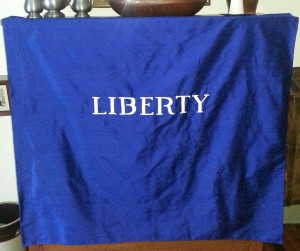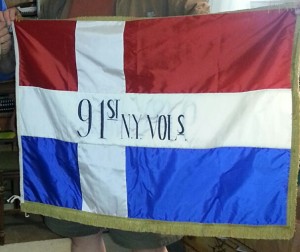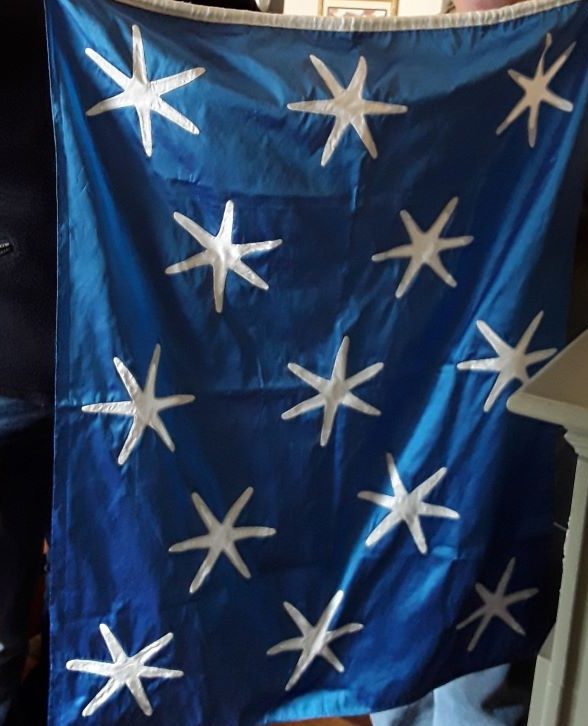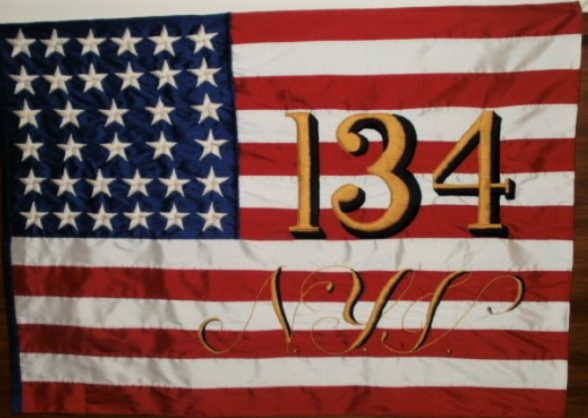Reproduction Flags
Throughout history, flags have identified their bearers as they claimed new lands, crossed oceans, met in battle, or represented their nation. Few items in living history today better symbolize eras gone by than the standard of a people’s spirit, military unit, province, state or nation. The colonial period of New York saw its fair share of colorful flags from the Dutch West India Company at Manhattan and Fort Orange in the 1620’s, to, perhaps, the first stars and stripes ever unfurled at Fort Schuyler (aka Stanwix) in August, 1777. In between were a host of national French, Dutch, and English flags, not to mention the provincial and military flags that were carried in their motherlands’ honor.

Liberty Flag, based on the discolored silk flag found in the Schenectady County Historical Society collection. Documents variously describe a blue, green or blue-green color. One client requested the blue you see here. Another requested blue-green. Click to enlarge
Some of these historic flags are well known and examples are even on display in museums, while others need research to find adequate descriptions to reproduce with reasonable accuracy. Things common to all flags in the colonial period, though, is that they were all made of natural fabrics, usually made of spun wool or silk. They were also hand sewn. Designs, such as stars, eagles, crosses, etc, were added by several different methods that included appliqué, embroidery and paint. No one in the colonial period, at least in the colonies, exclusively made flags simply because there was not enough of a demand to support a business or family. Normally, a person known for sewing prowess would be contracted to sew a flag together and could usually handle any embroidery or appliqué work needed. For more elaborate painted designs, a local artist might be sought out who could complete the desired concept. Luckily, Pam is a very talented artist who happens to have a master’s touch with sewing. We would be hard-pressed to think of a flag she could not reproduce.
Pam reproduces flags in the way they ought to be done – hand-sewn and true to the original. Descriptions found in documents and any existing photographs will be used to help determine the fabric, color and design needed to re-create a flag with reasonable accuracy. Where there are gaps in the documentary evidence, general practices of the day will be used. Re-created military units know their standards and needs best, so they are encouraged to provide as much detail as they can. In some cases, we are able to provide some assistance with determining which unit or regimental flags might be appropriate, with the goal being to produce a flag the unit will be proud to bear. Whether you need a flag for your re-created military unit, a living history program, or to add a colorful visual to a museum exhibit, you can expect a high quality reproduction that can stand the “is it hand made?” scrutiny of the re-enactment community.

The original silk battle flag reproduced here is found in the NYS Military Museum and Veterans Research Center in Saratoga. This is a regimental flank marker of the 91st Regiment of NY Volunteers, which was recruited from the Albany Capital District area from 1861 – 1865. A photograph of the original can be found at https://dmna.ny.gov/historic/btlflags/infantry/91stInfMarker.htm Click to enlarge.
Pam’s flag clientele goes beyond the American Revolution. Clients include Civil War re-enactors and enthusiasts who have requested military and non-military auxiliary unit flags. In fact, Pam can make just about any flag from any era as long as there is enough documentation to determine how to make it.
The price for Pam to make a flag suiting your needs begins at $100, plus the cost of the materials.
Prices may vary depending upon the amount of labor; typically, the more elaborate the design, the higher the cost. Contact us HERE to discuss pricing for a flag you would like to own.
Go HERE to see Pam’s page for more textile creations

This silk and applique flag is a reproduction of a flag purported to be the Headquarters, or “personal Position” Flag of General George Washington. It is said that it flew over his HQ at Valley Forge the winter of 1777-78. The flag Pam reproduced is based on an original in the Museum of the American Revolution at Philadelphia, which can be seen here: https://www.amrevmuseum.org/collection/washingtons-headquarters-flag Click to enlarge

Reproduction of a flank, or guide, flag of the Civil War 134th Regiment NY Volunteers. Note the exquisite embroidery of the lettering and stars on pieced silk. Based on the original in the New York State Military Museum and Research Center, NYS Division of Military and Naval Affairs, which can be seen here: https://dmna.ny.gov/historic/btlflags/infantry/134thInfGeneralGuideFlags.htm Click to enlarge


